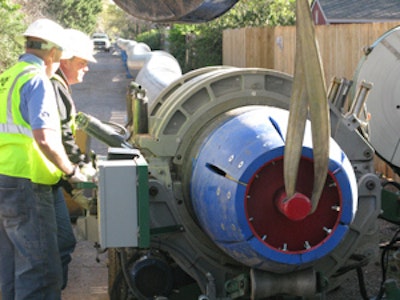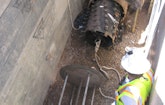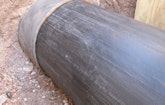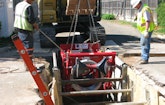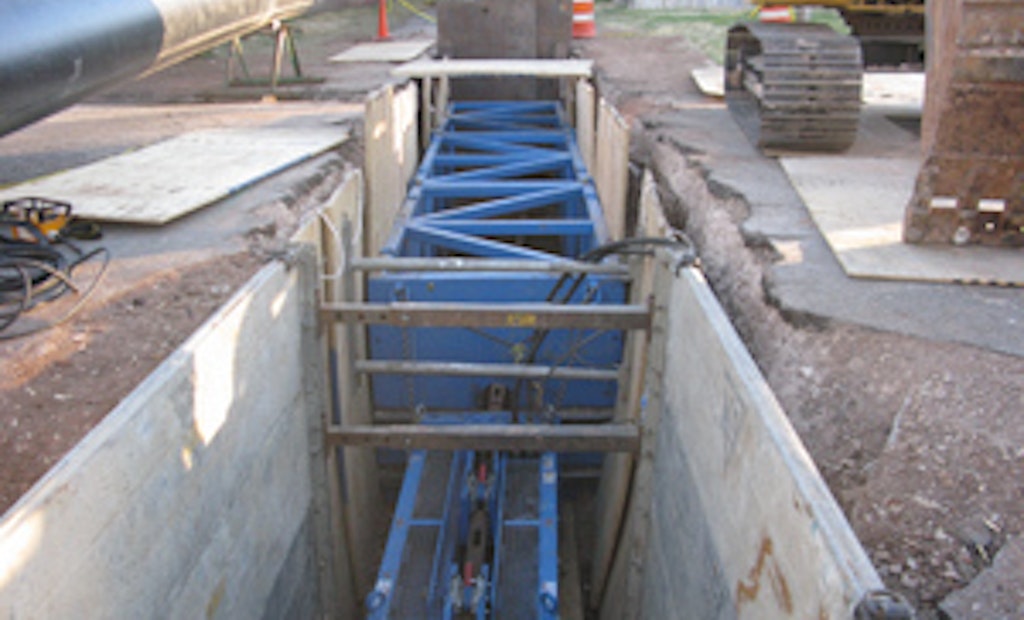
Interested in Relining/Rehab?
Get Relining/Rehab articles, news and videos right in your inbox! Sign up now.
Relining/Rehab + Get AlertsA leaking 30-inch cast-iron water transmission main was a long-standing problem for a neighborhood in Amarillo, Texas. Installed in 1927 when there were no houses, the 5,000-foot line supplies the Bonham Street Pump Station.
A 700-foot section crosses two streets and runs through easements between three rows of homes. Leaks sometimes percolated right next to the homes. The pipe then continues 1,300 feet through an alley behind the lots.
The Utilities Department installed leak clamps on the bad lead joints, but as the main became more important, the city decided to replace or line it. Dustin Davis, P.E., led the design, researching trenchless options on the Internet. He found technology from Swagelining Limited in Queens Quay, Clydebank, Scotland. The process pulls a slightly larger polymer pipe through a reduction die and into the smaller host pipe.
Davis determined that the system was somewhat less costly than cured-in-place pipe and that longer pull lengths reduced excavations and interventions, increased site mobility, and minimized the working footprint. “Swagelining is not a common practice around here,” says Emmett Autrey, director of utilities. “We stepped out a little bit on faith, but the process has a good track record overseas.”
Three contractors completed the project so efficiently that many residents wanting to watch missed the action. This was the first swagelining job completed in the municipal market in Texas, but it is used by the state’s oil and gas industries.
Combined effort
SAK Construction of Houston and Murphy Pipeline Contractors of Jacksonville, Fla., combined on the bid. Murphy specializes in swagelining, SAK in preparatory work and excavations. They subcontracted ISCO Industries in Mansfield, Texas, to supply and fuse 50-foot sticks of 32-inch HDPE pipe.
The city was in a long, record-breaking drought, and could shut down the critical artery for only brief periods. “The contractors were really under the gun to finish the project so we could continue to meet our water demands,” says Autrey. The low-pressure main transfers 17 to 20 mgd.
SAK Construction excavated and shored three 12-foot-deep pits, one on each end of the line and one in the middle for the reduction die. “Two excavations were in an alley, a busy place with one sewer line, two waterlines, and a gas line with cables running over it,” says Jim Blasczyk, SAK operations manager. “We had to move some utilities out of the way, but we avoided bypassing the sewer.”
SAK workers cut and removed 50-foot lengths of host pipe. The Murphy team then set up a self-contained hydraulic 1250G Grundoburst static ram from TT Technologies in the street at the head of the 700-foot section. SAK also televised the entire line. “It looked really good for an 84-year-old pipe,” says Blasczyk.
Workers then pulled a metal drag scraper and rubber pig through the pipe to remove tuberculation and tailings. “We knew the line was straight, but had no drawings of it, so SAK pulled through a proving pig,” says Jesse Flores, assistant water production superintendent. The short length of HDPE pipe emerged free of scrapes, confirming that the line had no obstructions or bends.
Murphy workers then set up the reduction die in the middle trench. At the same time, the ISCO team welded two 1,000-foot runs of HDPE pipe using a McElroy 1236 electrofusion machine, and laid them on elevated rollers. They recorded the temperature and data of each joint, which Davis and Flores inspected. “The welds must be stronger than the pipe,” says Bryan Fletcher, ISCO regional sales manager. “They have to withstand a pull of up to 3,000 psi when the two sections are joined together.”
Tension technology
The preparatory work took six weeks. Pulling in the two runs of pipe took 3.5 hours each. “Many residents came to watch,” says Larry West, water production superintendent. “They stood to the side and asked questions, and the contractors were really good about answering them and showing folks what they were doing.”
As ISCO workers fused the pulling head onto the HDPE pipe, the Murphy team linked together 3.9-inch QuickLock bursting rods 5 1/2 feet long until they reached the pit in the street. After they attached the lead rod to the pulling head, the ram pulled the pipe, under 70 tons of force, through the die, temporarily compressing the diameter for insertion into the host pipe.
“As long as we maintained tension on the pipe, it retained the 30-inch diameter,” says Andy Mayer, president of Murphy Pipeline. “Within two hours of releasing it, the pipe reverts 90 percent and regains full reversion overnight. The press-fit leaves no annular spaces.”
As the 187-pound rods appeared at the exit pit, workers unlinked and transported them to the alley, then fed them into that length of pipe. When the first section was completed, a crane lifted and turned the extrusion machine 180 degrees. The crew then completed the second run.
Meanwhile, SAK workers inserted 2-inch sampling taps every 1,000 feet as required by state law, filled the lines with water, and pressure-tested them. “We use the taps to chlorinate the line and sample it for coliform bacteria after flushing,” says Autrey. The water passed on the first inspection, and SAK restored the launch and exit pits.
“Residents now have a reliable pipe that doesn’t leak and is protected in a cast-iron wrapper,” says Flores. “We’ll use it again to complete the remaining 3,000 feet. Swagelining is fast and clean, and if residents didn’t live next to the transmission main, they’d never know anything was happening.”
